Unit7导学案
- 格式:doc
- 大小:123.00 KB
- 文档页数:23
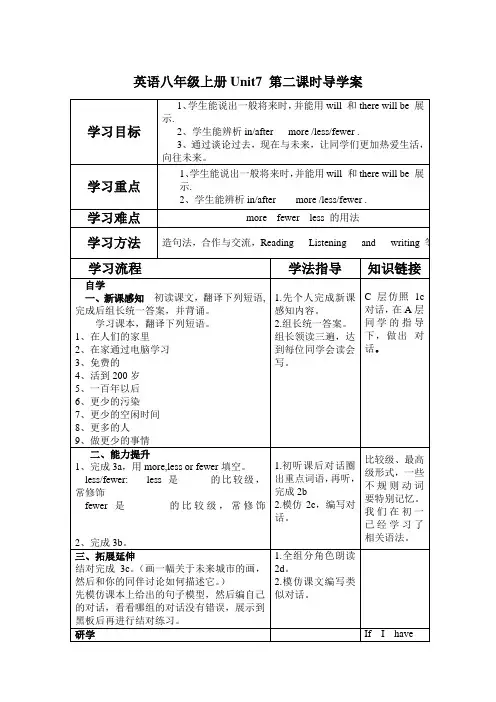
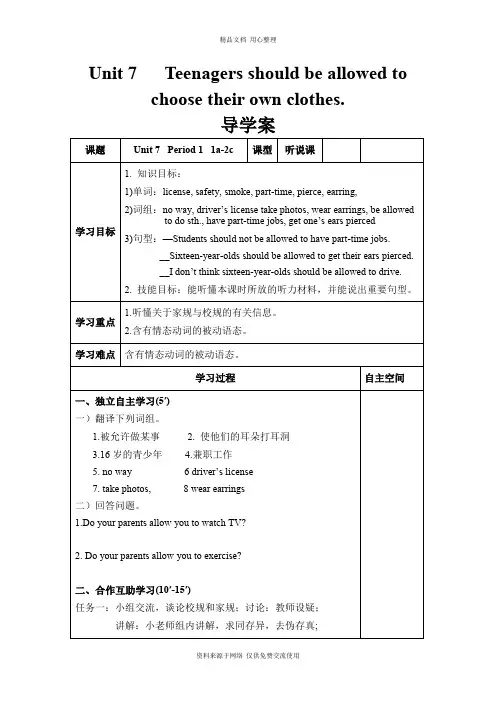
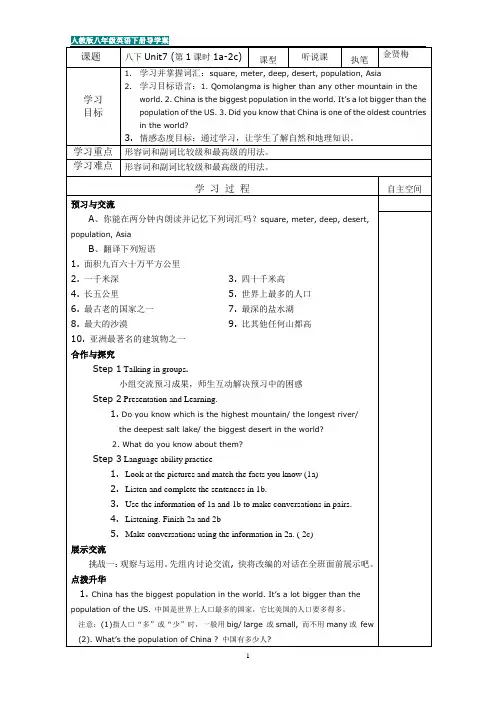
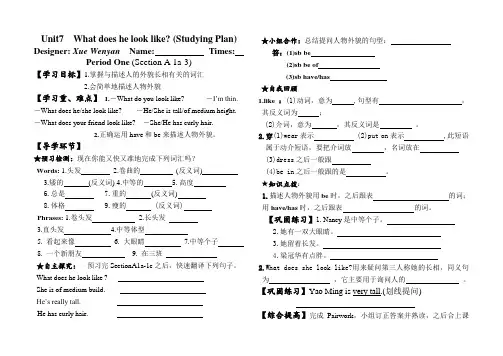
Unit7 What does he look like? (Studying Plan) Designer: Xue Wenyan Name: Times:Period One (Section A 1a-3)【学习目标】1.掌握与描述人的外貌长相有关的词汇2.会简单地描述人物外貌【学习重、难点】1.-What do you look like? -I’m thin.-What does he/she look like? -He/She is tall/of medium height. -What does your friend look like? -She/He has curly hair.2.正确运用have和be来描述人物外貌。
【导学环节】★预习检测:现在你能又快又准地完成下列词汇吗?Words: 1.头发 2.卷曲的(反义词)3.矮的(反义词)4.中等的5.高度6.总是7.重的(反义词)8.体格 9.瘦的 (反义词)Phrases: 1.卷头发 2.长头发__3.直头发4.中等体型5. 看起来像6. 大眼睛7.中等个子8. 一个新朋友9. 在三班★自主探究:预习完SectionA1a-1c之后,快速翻译下列句子。
What does he look like ?She is of medium build.He’s really tall.He has curly hair.★小组合作:总结提问人物外貌的句型:答:(1)sb be(2)sb be of(3)sb have/has★自我回顾1.like :(1)动词,意为 ,句型有,其反义词为;(2)介词,意为,其反义词是。
2.穿(1)wear表示 (2)put on表示 ,此短语属于动介短语,要把介词放,名词放在(3)dress之后一般跟(4)be in之后一般跟的是。
★知识点拨:1.描述人物外貌用be时,之后跟表的词;用have/has时,之后跟表的词。
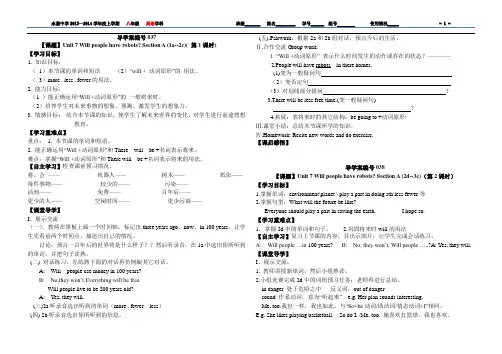
导学案编号037【课题】Unit 7 Will people have robots? Section A (1a--2c)( 第1课时)【学习目标】1. 知识目标:(1)本节课的单词和短语(2)―will + 动词原形‖的用法。
(3)more . less . fewer的用法。
2. 能力目标:(1 )能正确运用―Will +动词原形‖的一般将来时。
(2)培养学生对未来事物的想象、预测、激发学生的想象力。
3. 情感目标:结合本节课的知识,使学生了解未来世界的变化,对学生进行前途理想教育。
【学习重难点】重点: 1. 本节课的单词和短语。
2. 能正确运用―Will +动词原形‖和There will be +名词表示将来。
难点:掌握―Will +动词原形‖和There will be +名词表示将来的用法。
【自主学习】检查课前预习情况。
将、会——机器人——树木——纸张——每件事物——较少的——污染——活到——免费——百年后——更少的人——空闲时间——更少污染——【课堂导学】I、展示交流(一).教师在黑板上画一个时间轴,标记出three years ago、now、in 100 years,让学生先看前两个时间点,描述出自己的情况。
讨论:预言一百年后的世界将是什么样子??然后听录音,在1a中选出你所听到的单词,并把句子读熟。
(二) 对话练习。
先练熟下面的对话再仿例编其它对话。
A: Will people use money in 100 years?B: No,they won’t.Everything will be free.Will people live to be 200 years old?A: Yes, they will.(三)2a听录音选出听到的单词(more . fewer less)(四) 2b听录音选出你所听到的信息。
(五).Pairwork:根据2a和2b组对话,预言今后的生活。
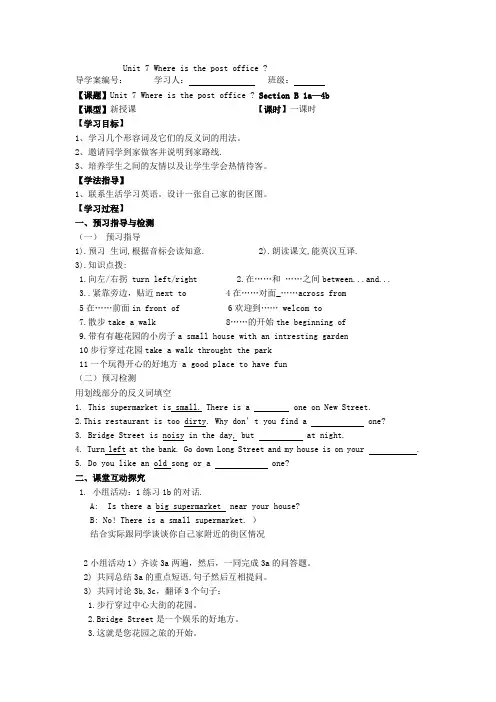
Unit 7 Where is the post office ?导学案编号:学习人:班级:【课题】Unit 7 Where is the post office ? Section B 1a—4b【课型】新授课【课时】一课时【学习目标】1、学习几个形容词及它们的反义词的用法。
2、邀请同学到家做客并说明到家路线.3、培养学生之间的友情以及让学生学会热情待客。
【学法指导】1、联系生活学习英语。
设计一张自己家的街区图。
【学习过程】一、预习指导与检测(一)预习指导1).预习生词,根据音标会读知意. 2).朗读课文,能英汉互译.3).知识点拨:1.向左/右拐 turn left/right2.在……和……之间between...and...3..紧靠旁边,贴近next to 4在……对面_……across from5在……前面in front of 6欢迎到…… welcom to7.散步take a walk 8……的开始the beginning of9.带有有趣花园的小房子a small house with an intresting garden10步行穿过花园take a walk throught the park11一个玩得开心的好地方 a good place to have fun(二)预习检测用划线部分的反义词填空1. This supermarket is small. There is a one on New Street.2.This restaurant is too dirty. Why don’t you find a one?3. Bridge Street is noisy in the day, but at night.4. Turn left at the bank. Go down Long Street and my house is on your .5. Do you like an old song or a one?二、课堂互动探究1. 小组活动:1练习1b的对话.A: Is there a big supermarket near your house?B: No! There is a small supermarket. )结合实际跟同学谈谈你自己家附近的街区情况2小组活动1)齐读3a两遍,然后,一同完成3a的问答题。
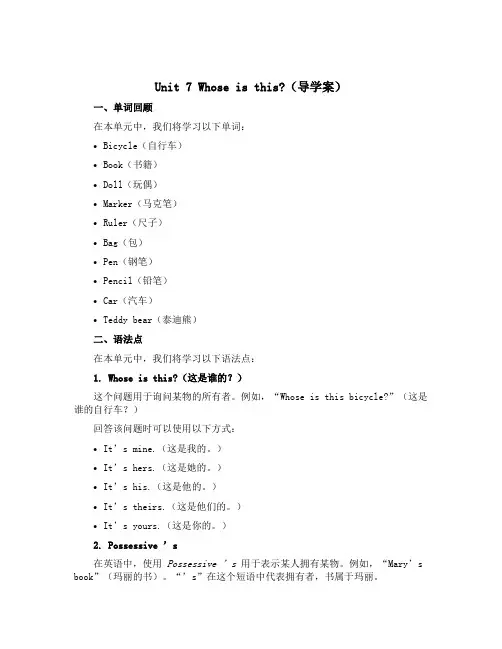
Unit 7 Whose is this?(导学案)一、单词回顾在本单元中,我们将学习以下单词:•Bicycle(自行车)•Book(书籍)•Doll(玩偶)•Marker(马克笔)•Ruler(尺子)•Bag(包)•Pen(钢笔)•Pencil(铅笔)•Car(汽车)•Teddy bear(泰迪熊)二、语法点在本单元中,我们将学习以下语法点:1. Whose is this?(这是谁的?)这个问题用于询问某物的所有者。
例如,“Whose is this bicycle?”(这是谁的自行车?)回答该问题时可以使用以下方式:•It’s mine.(这是我的。
)•It’s hers.(这是她的。
)•It’s his.(这是他的。
)•It’s theirs.(这是他们的。
)•It’s yours.(这是你的。
)2. Possessive ’s在英语中,使用Possessive ’s用于表示某人拥有某物。
例如,“Mary’s book”(玛丽的书)。
“’s”在这个短语中代表拥有者,书属于玛丽。
三、课文导读本单元的主要交际目标是询问物品的所有者。
我们将学习如何使用这个问题和如何回答它。
在本单元中,我们将了解到三个孩子和他们的物品。
杰克有一个自行车,凯特有一本书,而山姆有一个玩偶。
我们将学习如何询问物品的所有者,学习使用Possessive’s表示所有权,以及学习如何回答这样的问题。
这些都将有助于我们更好地交流和理解。
四、小结本单元,我们学习了如何使用“Whose is this?”问题来询问物品的所有者。
我们学习了使用Possessive’s表示某人拥有某物,并且学习了回答这个问题的几种不同方式。
在未来的交际中,我们可以使用这些语言技巧来更好地交流和理解。
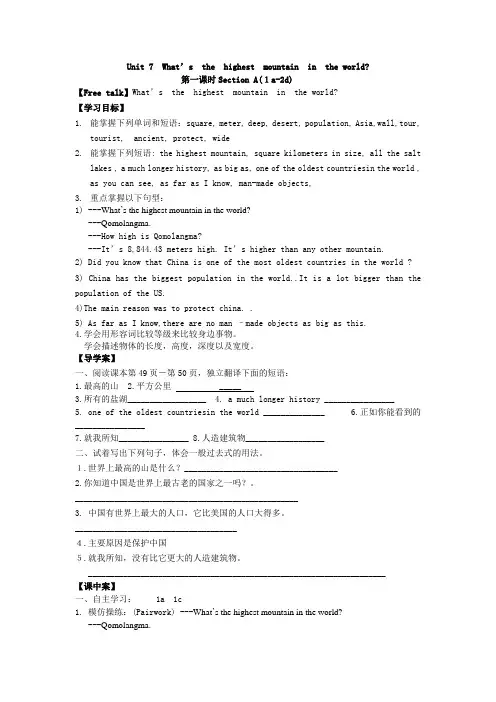
Unit 7 What’s the highest mountain in the world?第一课时Section A(1a-2d)【Free talk】What’s the highest mountain in the world?【学习目标】1.能掌握下列单词和短语:square, meter, deep, desert, population, Asia,wall,tour,tourist, ancient, protect, wide2.能掌握下列短语: the highest mountain, square kilometers in size, all the saltlakes , a much longer history, as big as, one of the oldest countriesin the world , as you can see, as far as I know, man-made objects,3.重点掌握以下句型:1) ---What’s the highest mountain in the world?---Qomolangma.---How high is Qomolangma?---It’s 8,844.43 meters high. I t’s higher than any other mountain.2) Did you know that China is one of the most oldest countries in the world ?3) China has the biggest population in the world..It is a lot bigger than the population of the US.4)The main reason was to protect china. .5) As far as I know,there are no man –made objects as big as this.4.学会用形容词比较等级来比较身边事物。
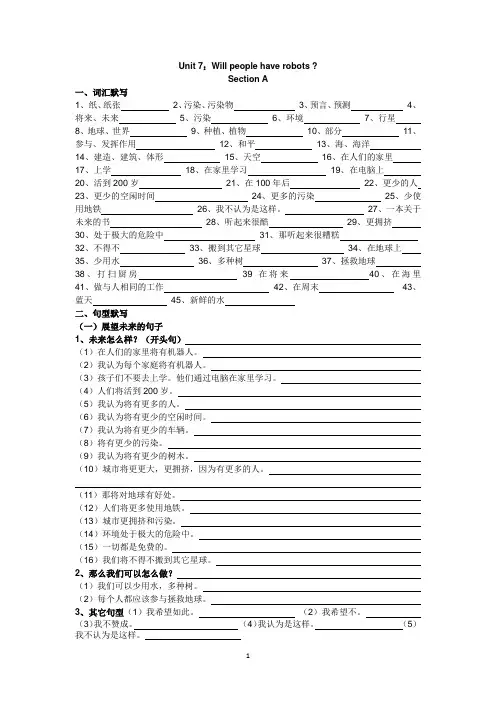
Unit 7:Will people have robots ?Section A一、词汇默写1、纸、纸张2、污染、污染物3、预言、预测4、将来、未来5、污染6、环境7、行星8、地球、世界9、种植、植物10、部分11、参与、发挥作用12、和平13、海、海洋14、建造、建筑、体形15、天空16、在人们的家里17、上学18、在家里学习19、在电脑上20、活到200岁21、在100年后22、更少的人23、更少的空闲时间24、更多的污染25、少使用地铁26、我不认为是这样。
27、一本关于未来的书28、听起来很酷29、更拥挤30、处于极大的危险中31、那听起来很糟糕32、不得不33、搬到其它星球34、在地球上35、少用水36、多种树37、拯救地球38、打扫厨房39在将来40、在海里41、做与人相同的工作42、在周末43、蓝天45、新鲜的水二、句型默写(一)展望未来的句子1、未来怎么样?(开头句)(1)在人们的家里将有机器人。
(2)我认为每个家庭将有机器人。
(3)孩子们不要去上学。
他们通过电脑在家里学习。
(4)人们将活到200岁。
(5)我认为将有更多的人。
(6)我认为将有更少的空闲时间。
(7)我认为将有更少的车辆。
(8)将有更少的污染。
(9)我认为将有更少的树木。
(10)城市将更更大,更拥挤,因为有更多的人。
(11)那将对地球有好处。
(12)人们将更多使用地铁。
(13)城市更拥挤和污染。
(14)环境处于极大的危险中。
(15)一切都是免费的。
(16)我们将不得不搬到其它星球。
2、那么我们可以怎么做?(1)我们可以少用水,多种树。
(2)每个人都应该参与拯救地球。
3、其它句型(1)我希望如此。
(2)我希望不。
(3)我不赞成。
(4)我认为是这样。
(5)我不认为是这样。
1三、单元语法讲练:一般将来时1、结构:(1)be going to +动词原形(2)will+动词原形2、标志性时间状语:tomorrow、tonight、next+时间、in+时间段(in two months两个月后、in five minutes 五分钟之后)、in the future (在将来)、soon(不久、很快)、the day after tomorrow等表示将来的时间。
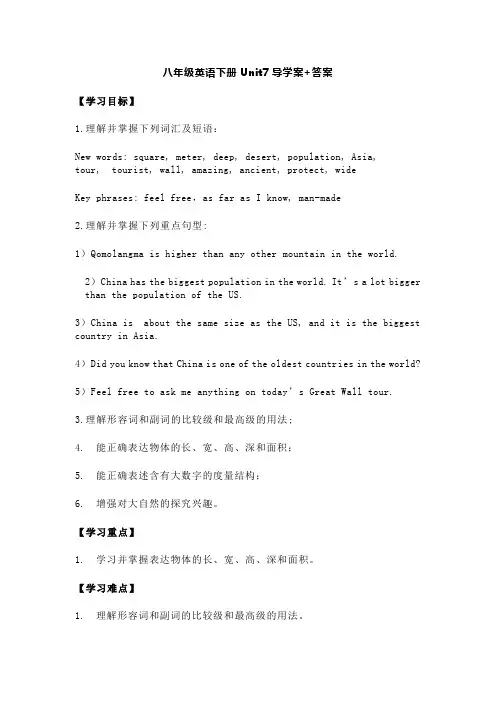
八年级英语下册Unit7导学案+答案【学习目标】1.理解并掌握下列词汇及短语:New words: square, meter, deep, desert, population, Asia,tour, tourist, wall, amazing, ancient, protect, wideKey phrases: feel free,as far as I know, man-made2.理解并掌握下列重点句型:1)Qomolangma is higher than any other mountain in the world.2)China has the biggest population in the world. It’s a lot bigger than the population of the US.3)China is about the same size as the US, and it is the biggest country in Asia.4)Did you know that China is one of the oldest countries in the world?5)Feel free to ask me anything on today’s Great Wall tour.3.理解形容词和副词的比较级和最高级的用法;4. 能正确表达物体的长、宽、高、深和面积;5. 能正确表述含有大数字的度量结构;6. 增强对大自然的探究兴趣。
【学习重点】1. 学习并掌握表达物体的长、宽、高、深和面积。
【学习难点】1. 理解形容词和副词的比较级和最高级的用法。
2. 学会含有大数字的度量结构的表述。
【课前预习】Ⅰ. 重点词汇。
1. 亚洲___________2. 深的___________3. 沙漠___________4. 人口;人口数量___________5. 墙___________6. 平方;正方形___________7. 米;公尺___________8. 宽的;宽阔的___________9. 古代的;古老的___________10. 保护;防护___________ 11. tourist ___________ 12.tour ___________Ⅱ. 短语互译。
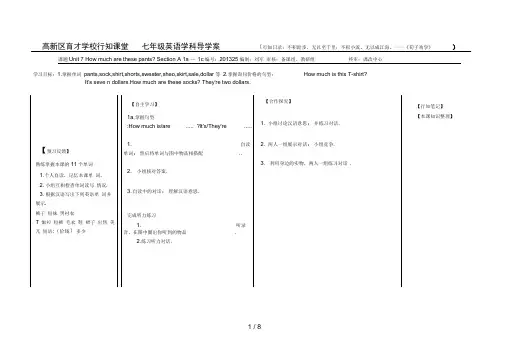
高新区育才学校行知课堂七年级英语学科导学案(行知日录:不积跬步,无以至千里;不积小流,无以成江海。
一一《荀子劝学》 )课题Unit 7 How much are these pants? Section A 1a — 1c 编号:201325编制:刘军 审核:备课组、教研组 终审:课改中心 学习目标:1.掌握单词 pants,sock,shirt,shorts,sweater,sheo,skirt,sale,dollar 等 2.掌握询问价格的句型: How much is this T-shirt? It's seve n dollars.How much are these socks? They're two dollars.【行知笔记】 【本课知识整理】年级英语学科导学案(行知日录:不积跬步,无以至千里;不积小流,无以成江海。
《荀子劝学》)高新区育才学校行知课堂二>我展示—精彩"5-^展示内容我精彩^【展示点拨】翻译句子:---这个帽子多少钱?---五美元.? .总结:当我们询问物品的价格时,回答的时候需要注意什么?---这些袜子多少钱?- ?【拓展提升】(三)根据汉语完成句子1.这条裤子多少钱?20美元.【目标检测】(一)根据句意和首字母完成单词1. The blue hat is seve n d2. How much _____ t he pan ts?3. How much are the ______ (短袜)?____________ two dollars.4. My ________ (毛衣)is red.5. _____________ —How m isyour skirt?—20dollars.(二)单选题1. How much __A. isB. amthese pan ts?C. areD. do2. —How much are the blacksocks?【行知笔记】【本课知识整理】2.这件衬衣多少钱? 8美兀.? .3.你的帽子多少钱? 3美兀.? .4.那个白色的书包多少钱??句型转换1.The red sweater is 15 dollars.(对划线部分提问)??2.Her father has a white shirt.(改为否定句)A. It's 10 yua n.B. It's 10 yua ns.C. They're 10 yua n.D. They're 10 yua ns.3. Where ______ y our new pan ts? _______ onthe bed.A. is, It'sB. are, They'reC. is, They'reD. are,I t's【教师寄语】行知课堂,我展示,我快乐,我成功!课题课题Unit 7 How much are these pants?第二课时编号:201325编制:刘军审核:备课组、教研组终审:课改中心总结一下购物的常用语•翻译下列句子•1. —这个黑包多少钱?一8美元。
Unit 7 How much are these socks ?(第1课时)课题:Unit 7 Section A(1a-2e) 主备人: 年级: 班级: 姓名: 日期:老师寄语:Let life be beautiful like summer flow ers. 愿生如夏花之绚烂。
一、目标导学1. 熟记词汇探究的新单词,正确完成知识探究内容。
2. 学习如何询问价格。
3. 学习有关服装、颜色的词汇。
二、自主探究1. 词汇探究:给下列单词和短语正确连线。
2. 听力探究:仔细阅读题目要求,完成听力练习1b, 2b, 2c 。
3. 知识探究:1) 美元与人民币的区别:dollar, “美元”, 符号“$”, 有单复数之分。
E.g.:二十美元,20 dollars, $20. yuan, 是人民币的单位“元”,符号“¥”,无单复数之分。
E.g.:20元,20 yuan, ¥20.针对练习:That coat is ____. A. 100 dollar B. 100 dollars C. 100 $ D. 100 yuans2) How much...? 询问价格。
How much + is + 可数名词单数/不可数名词/it? 回答:(It ’s +)价格。
How much + are + 可数名词的复数/the y? 回答:(They ’re +) 价格。
How much is/are... ? = What ’s the price of ... ? “...的价格是多少?”针对练习:选词填空(It ’s 或They ’re )① How much is this skirt? _____ $7. ② How much are these socks? _____ two yuan.3) ① Can I help you? 意为“我能帮您吗?”,是向别人提供帮助的说法。
类似句型有: May I help you? What can I do for you? Is there anything I can do for you? ② What color...? 意为“...颜色?”。
人教版新目标七年级下册英语导学案Unit7 It’s raining.第1课时 Section A(P37.38 页1a—2c)班级: 姓名:教师寄语:Save for a rainy day. 未雨绸缪。
【学习目标】1、知识与技能:掌握单词2、过程与方法: 1)、听说训练2)、能利用所学知识进行话。
.3、情感态度、价值观:积极参与小组活动,大胆展示。
【学习重点】1.学会使用学问天气状况的用法,及答语句型—How is the weather.It’s cloudy2.学会【学习过程】一、课前预习1.自己拼读、听磁带朗读单词,背单词。
2.听本节录音材料,并跟读。
3.单词检测下雨;雨水多雨的_________ 风多风的云____________ 多云的晴朗的_________ 下雪;雪天气做饭4.短语玩篮球看电视像往常5. 重点句型1. 上海的天气怎么样?多云2.北京的天气怎么样?天气晴朗3. 莫斯科的天气怎么样现在正在下雪4.多伦多的天气怎么样?像往常一样,正在下雨5. 乔叔叔在那吗?不,不在。
他在外面。
6.乔叔叔在做什么?7. 萨利婶婶在哪吗?是的,她在,但是她现在正在忙。
8.你想和她谈话,不是吗?二、课堂学习Step1 Free talkTry to speak out the names of weather you know.Step2 Presentation1.Learn the new words about weather in 1a.2.Finish 1a. Then check the answers.3.Look at the picture in 1a and learn the drills:--How’s the weather in …? -- It’s ….Step3 ListeningListen and finish 1b. Check the answers.Step4 Pair workPractice the conversations in 1a .Then make your own conversations. Step5 Presentation1.Look at the picture in 2a.2.Guess what the people are doing.Step6 Listening1. Listen to the tape. Finish2a.2. Go through the sentences in 2b.3. Listen and finish 2b. Check the answers.Step7 Pair work1. Ask and answer questions with your partner. Finish 2c.三、过关检测:(一)根据句意,补全已给出首字母的单词1. ---The w in Beijing is hot now.2.---It smells so good.---My sister is c fish in the kitchen.3.---What do you do on r days.---I read some books at home.4.---The sky is so blue.---Yes, it is a s day.(二)用所给词的适当形式填空1. ---Look! They (study) in the classroom.2. ---My brother often (watch) football matches on TV.3. ---We can’t go out now. It’s (rain) so hard.4. ---It’s (cloud), but it’s very hot.【拓展延伸】1. 询问天气状况的用法:问:How’s the weather in + 地点= What’s the weather like in + 地点答:It’s + 表示天气状况的形容词Eg: the weather in Shanghai?= the weather like in Shanghai.?It’s cloudy/ windy/ sunny/ foggy2. Weather 的含义weather 意为“天气”,为不可数名词,不能与a 或an 连用。
Unit7 Will people have robots?课时 1 Section A (la-2d)主备人:彭佳佳 复备人:八年级英语组 审查人:衡永旭【学习目标】一、 初步了解Will 表示一般将来时的用法和there be 句型的一般将来时的用法。
二、 重点掌握w 订1构成的一般将来的陈述句、否定句、疑问句及其回答。
(重点)•、你能翻译下列短语吗?7. live to be years old ________________________8. ___________________ 在家学习 ____________________ 9.更少的污染【课堂导学】1・will people have robots?人们将会有机器人吗?本句是由助动词will 构成的一般将来时的一般疑问句。
其句型结构为"Will/Shall+主 语+dosth.?” 一般将来时表示在将来某个时间要发牛的动作或存在的状态,常与表示将 来的吋间状语连用,如:tomorrow, next month (week/year ), in lOOyears 等。
这种将来 意义常常有说话人的主观态度和看法。
• 一w 订 1 your brother come back in two weeks?你哥哥两周后会回来吗? 一yes, he will. /NO, he won t.是的,他会/不,他不会。
2. paper 作“纸;纸张”讲时,为不可数名词。
表示“一张纸”用a piece of paper,"两张纸”用 two pieces of paper 。
• The paper is macle from wood 。
纸是木头做的。
• Could you please give me a piece of paper?你能给我一张纸吗? paper 还可做棵树名词,意为“论文;报纸,试卷”。
• The students hand in their papers on time.学生们按时叫上他们的试卷。
Unit 7Teenagers should be allowed to choose their own clothes.课时分解课堂环节§自主学习方案【新词自查】根据句意及汉语提示完成句子。
1.The policeman asked the driver to show his driver’s license(证件).2.My mother doesn’t like the girl who wears the earrings(耳环).3.Most of the parents are worrying about their children’s safety(安全).4.My father coughed badly,the doctor asked him to give up smoking(吸烟).5.Nowadays teenagers (青少年) have many different thoughts.§课堂导学方案Step 1情景导入参考案例每个青少年在生活中都会碰到允许或者不允许做某事,例如在商场购物时,我们应该允许选择自己的衣服,而作为父母却不允许我们选择自己的衣服,你们有这样的经历吗?你们是赞同还是不赞同呢,请大家说出自己的观点。
(4分钟)Teacher: Could you tell me what students should be allowed to do or shouldn’t be allowed to do?Students:_________________________________①Students should be allowed to have part-time jobs.②Students shouldn’t be allow ed to get their ears pierced.…环节说明:通过课前的一个师生问答互动,让学生对自己感兴趣的话题产生共鸣,能调动学生学习的积极性,同时be allowed to do的应用,为学习新课埋下了伏笔。
Unit7. It’s raining!1a—2c (Period 1)教师寄语:All things are difficult before they are easy. 凡事都是先难后易。
【学习目标】1. 学会使用How’s the weather?这询问天气状况的句型。
2. 会用英语描述天气,谈论在不同天气里所做的事情。
3. 学会通过询问天气展开话题,提升与人交流的水平。
4.重点单词:rain-raining-rainy wind-windy cloud-cloudy sun-sunny snow-snowing-snowy weather cook-cooking5.重点短语:Play computer games play basketball watch TV in Moscow /Toronto/ Boston6.重点句型:How is the weather +(in)+地点?=What is the weather like +(in)+地点?答:It’s +现在分词=It’s +adj。
【课前探究】(先蓝色笔做,用红笔订正。
)一、课前预习,根据音标写出英文和中文。
[reɪn]_________( ) ['reɪnɪ] _______( ) [wɪnd]__________( ) ['wɪndɪ]_________( )[klaʊd]________( ) ['klaʊdɪ] _______( ) ['sʌnɪ] __________( ) ['snəʊɪ] __________( )总结:名词+______, 构成adj.。
如:名词wind+y--windy;rain—rainy; cloud—cloudy; 特殊:sun—Sunny;二、理解记忆--重点句子。
1. How’s the weather in Shanghai/Beijing/Moscow/Toronto/Boston?2. It’s raining/cloudy/snowing/sunny.=What’s the weather like in…..today? 回答或者用“It’s sunny/windy/snowy/rainy cold/hot/warm/cool/ dry…”3.中考考感叹句:What bad weather! 注:weather “天气”, 是不可数名词。
Unit7 Would you mind turning down the music?Section A主备人:吕春苗二备人:一、学习目标:掌握词汇:not at all , turn down, yard, right away, task交际用语:1.--Would you mind doing sth?--I‟m sorry , I‟ll do it right away.不介意:Not at all. Do it as you like. \Of course not.\Certainly not介意:Sorry, but I do .You‟d better not.2. --Could you please wash the dishes?--Ok, I …ll do them in a minute.二、教学重难点:Would you mind doing sth? 的回答。
三、学习过程:Step1、预习导学及自测:尝试性求知::1)Would you mind _________(turn down) the music?2)Would you mind __________(not play) football here?3)Could you please_________ (help) me learn French?Step2、情境导入:当别人的行为影响了你,你该怎样提出建议呢?当你的行为影响了别人并被指出后你该怎样表示歉意呢?你能委婉地表达自己的意见而成为一个有礼貌的人吗?Step3、自主探究:Let students try to read, learn and memorize the new words by themselves.英汉词组互译:1)do the dishes______2)look terrible_____3)put on_______4)go shopping_____ 5)一点也不______ 6)调低,关小_______7)立刻,马上____ 8)帮我做作业________ 9)在开会_________10)照顾你的小表弟________11)介意做某事______12)清扫院子_______ 13)需要帮助_______Step4、合作交流:⑴看图,说说:Look at the pictures in 1a and talk about the situations in groups.(Do 1a) What are you going to do with the situations? What should you say?⑵听听,练练Listen to the tape and work in pairs .(Do 1b,1c and 2a ,2b)⑶看图,写写Look at the pictures and complete the note.(Do 3a)Step5、拓展创新:、用“would you ”“could you ”和“have to ”填空.A:_______mind getting up ?You ________help me in the kitchen.B:OK,I‟ll get up right away. Do I_______wash the dishes ?A:Yes,and you _______help me make dinner.B:OK,when I finish, ______help me with my homework?A:Sure.以上面情境为模板,小组做对话。